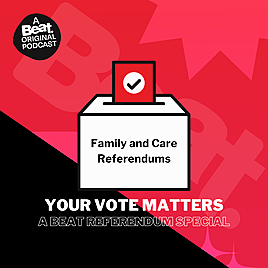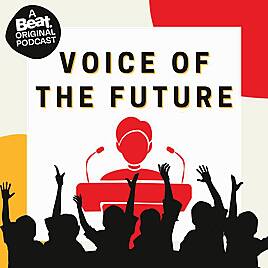
Shake It Like a Polaroid Picture Edition Part 2
25 August 2023 - 36 minsTalk about ’90s rap, and most music fans will throw around the word “gangsta” and talk about the East Coast–West Coast feud that tragically brought down Biggie and Tupac. But one rap group, OutKast, quite literally rose above the fray: At the 1995 Source Awards, while East and West were bickering with each other, OutKast’s André Benjamin took the mic and told the rap faithful that hip-hop’s future was in the South. For the next quarter century, he was proved indisputably correct.
OutKast brought about this sea change by conceiving of hip-hop as everything music: funk, soul, pop, club, even country and indie all found their way into André and Big Boi’s music. By the time of their final studi...

Pour Some Sugar on Me Edition Part 2
When you hear the term “superproducer,” names like George Martin, Quincy Jones, Max Martin, Pharrell Williams or Missy Elliott might come to mind. But … Robert “Mutt” Lange? Probably not. Yet Lange was by some measures the biggest hitmaker—the producer of more top-selling albums than any of those better-known producers. The South African studio wiz crafted the arena-rock sound of AC/DC and Def Leppard. Then, Lange transformed the Cars, Billy Ocean, Bryan Adams, and Shania Twain into fist-pumping stadium-fillers, too. Join Chris Molanphy as he traces Mutt Lange’s legacy of loud—and his uncanny success on the pop charts. He poured sugar on every hit. Podcast production by Kevin Bendis. Get more Hit Parade with Slate Plus! Join for monthly early-access episodes, bonus episodes of "The Bridge," and ad-free listening across all your favorite Slate podcasts. Subscribe directly from the Hit Parade show page on Apple Podcasts or Spotify. Or, visit slate.com/hitparadeplus to get access wherever you listen. Learn more about your ad choices. Visit megaphone.fm/adchoices
56 mins
28 November Finished

Pour Some Sugar on Me Edition Part 1
When you hear the term “superproducer,” names like George Martin, Quincy Jones, Max Martin, Pharrell Williams or Missy Elliott might come to mind. But … Robert “Mutt” Lange? Probably not. Yet Lange was by some measures the biggest hitmaker—the producer of more top-selling albums than any of those better-known producers. The South African studio wiz crafted the arena-rock sound of AC/DC and Def Leppard. Then, Lange transformed the Cars, Billy Ocean, Bryan Adams, and Shania Twain into fist-pumping stadium-fillers, too. Join Chris Molanphy as he traces Mutt Lange’s legacy of loud—and his uncanny success on the pop charts. He poured sugar on every hit. Podcast production by Kevin Bendis. Get more Hit Parade with Slate Plus! Join for monthly early-access episodes, bonus episodes of "The Bridge," and ad-free listening across all your favorite Slate podcasts. Subscribe directly from the Hit Parade show page on Apple Podcasts or Spotify. Or, visit slate.com/hitparadeplus to get access wherever you listen. Learn more about your ad choices. Visit megaphone.fm/adchoices
1 hour 3 mins
15 November Finished

Pour Some Sugar on Me Edition Part 1
When you hear the term “superproducer,” names like George Martin, Quincy Jones, Max Martin, Pharrell Williams or Missy Elliott might come to mind. But … Robert “Mutt” Lange? Probably not. Yet Lange was by some measures the biggest hitmaker—the producer of more top-selling albums than any of those better-known producers. The South African studio wiz crafted the arena-rock sound of AC/DC and Def Leppard. Then, Lange transformed the Cars, Billy Ocean, Bryan Adams, and Shania Twain into fist-pumping stadium-fillers, too. Join Chris Molanphy as he traces Mutt Lange’s legacy of loud—and his uncanny success on the pop charts. He poured sugar on every hit. Podcast production by Kevin Bendis. Learn more about your ad choices. Visit megaphone.fm/adchoices
15 November Finished

The Slate Culture Gift Guide
Hark, the holiday season is upon us—and with it, the most solemn of festive traditions: a gift guide! In this video and podcast special, Slate hosts Dana Stevens, Chris Molanphy, and Willa Paskin beam in from their collective hearths to deliver unto the internet their favorite gifts for culture lovers. In addition to sharing gifts, they also discuss the cultural artifact that is the “holiday gift guide,” and its history going back to the early 20th century, up to the modern day. See the entirety of the 1910 gift guide Our Special Holiday Gift-Book from Greenhut-Siegel Cooper, and Esquire’s ultra-mod gift guide from 1961. Check out our gift recommendations below: Dana Stevens’ Cozy Movie Night-In: The Salbree Collapsible Silicone Microwave Popcorn Popper & Amish Country Popcorn L'agraty Chunky Knit Blanket Throw The Adventures of Antoine Doinel, The Criterion Collection Box Set Chris Molanphy’s Hit Parade Collection: The Beatles’ Revolver CD Box Set Mad Men Blu-Ray Box Set Can't Slow Down: How 1984 Became Pop's Blockbuster Year, by Michaelangelo Matos Willa Paskin’s Fruit-Themed Trompe-l'œil Housewares: Cantaloupe-shaped bowls in the style of Bordallo Pinheiro 4-Pack Orange-Shaped Candle Stocking Stuffer Cherry-Shaped Toilet Brush The Slate Culture Gift Guide is produced for Slate Studios by Benjamin Frisch and Micah Phillips, with Meryl Bezrutczyk and Andrew Harding. Learn more about your ad choices. Visit megaphone.fm/adchoices
49 mins
12 November Finished

If You Love Sting, Set Him Free Edition Part 2
Walk into any store or flip on a radio, and you’ll probably hear the Police’s “Every Breath You Take” sooner or later. Thanks to that ubiquity, the swooning, menacing megahit’s songwriter—Sting—is a very wealthy man. Now his former bandmates, Stewart Copeland and Andy Summers, are suing Sting over who deserves to profit from “Breath” and other Police songs. No matter how that dispute turns out, it’s a reminder of Sting’s uncanny songwriting skill and his charmed life of hitmaking. For more than four decades, Sting seems to resurface every few years with a new earworm, from “Roxanne” to “Russians,” blending New Wave rock with another genre—reggae, jazz, classical, country, even rap and Raï—and in the process, getting sampled by new generations of millennial and zoomer hitmakers. Join Chris Molanphy as he recounts the long, varied, sophisticated, but catchy career of the King of Pain. Whatever he tries, every little thing Sting does is magic. Learn more about your ad choices. Visit megaphone.fm/adchoices
55 mins
31 October Finished

If You Love Sting, Set Him Free Edition Part 1
Walk into any store or flip on a radio, and you’ll probably hear the Police’s “Every Breath You Take” sooner or later. Thanks to that ubiquity, the swooning, menacing megahit’s songwriter—Sting—is a very wealthy man. Now his former bandmates, Stewart Copeland and Andy Summers, are suing Sting over who deserves to profit from “Breath” and other Police songs. No matter how that dispute turns out, it’s a reminder of Sting’s uncanny songwriting skill and his charmed life of hitmaking. For more than four decades, Sting seems to resurface every few years with a new earworm, from “Roxanne” to “Russians,” blending New Wave rock with another genre—reggae, jazz, classical, country, even rap and Raï—and in the process, getting sampled by new generations of millennial and zoomer hitmakers. Join Chris Molanphy as he recounts the long, varied, sophisticated, but catchy career of the King of Pain. Whatever he tries, every little thing Sting does is magic. Learn more about your ad choices. Visit megaphone.fm/adchoices
1 hour 7 mins
18 October Finished





















